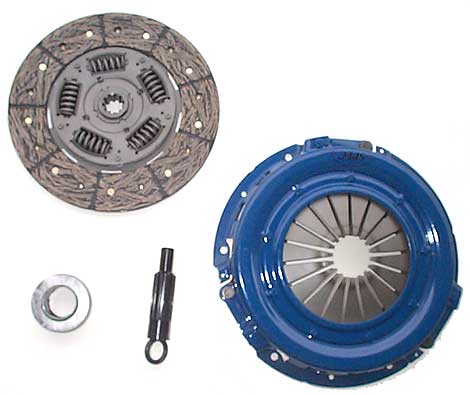
Automatics are boring. Let's face it, stabbing the clutch
and shifting the gears is the essence of performance driving.
Automatic transmissions certainly have their benefits,
and we enjoyed ours thoroughly, and were impressed with
how it responded to minor modifications such as a shift
kit and higher stall converter. However, as we had always
planned from the moment we bought the '88 LX, the time
has come for the AOD tobe replaced with a T5 manual.
We performed the swap for several reasons including the
fun factor. We wanted a performance gain, not only from
better gearing in the T5, but also due to the less parasitic
loss, not to mention the weight loss. An AOD is roughly
40lbs heavier than the T5. Furthermore we hope the T5
will result in better fuel economy, due to the lower overdrive
rpms as a result of the lower gear ratio and by eliminating
the slippage of the non-lockup converter.
Performing
a T5 swap in a late-model Mustang is very easy. In order
to reduce assembly line costs, Ford setup the FOX platform
to accept either the AOD or the T5 with minimal parts
differences or chassis modifications. The starter, driveshaft,
crossmember, transmission mount and speedo-cable are all
interchangeable.
Other
than acquiring the T5 itself, the pedal assembly, the
clutch parts, and the console plate and boot, there is
not much else that is needed, other than a spare weekend
to perform the job. It is important to mention that T5
cars used a different EEC-IV processor than AOD cars.
It is not necessary to change to a manual processor. In
fact, it is recommended that you don't because the manual
processor requires a wiring harness that is not found
in the automatic cars. Without this harness the manual
computer cannot complete the self-tests, meaning you can't
"pull" diagnostic trouble codes. If you simply leave the
automatic processor in place, the self-tests and codes
will function properly.
The actual swap is fairly simple to perform, and will
take anywhere from 10-16 hours, depending on your experience
and how many friends show up to give you a hand. We actually
installed the pedal assembly months before we installed
the T5, just to get a head start. Believe it or not, the
pedal assembly is probably the most difficult part of
the entire swap! It took about three hours to complete,
including rerouting the speedo cable, which on automatic
cars is routed through the clutch cable hole. The rest
of the swap consists of removing the AOD and associated
parts, and then essentially performing a clutch job and
installing the T5.
Finding
all the parts is not all that tough either. We got lucky
and found someone parting out a low-mileage 1992 Mustang
in the local classified. We struck a deal on all the T5
parts, including the transmission for $500.
Perhaps the most sought-after parts are the console cover,
rubber insulator, and leather boot. We were fortunate
that the donor car had these intact and in great shape.
When taking the pedal assembly, be sure to get all the
switches mounted on it. Take every little piece of hardware
you can, since many of the small parts are Ford pieces
that are not sold anymore, or are very expensive.
|
 (Clutch
Pedal Installation.) (Clutch
Pedal Installation.) |
| |
|
|
|
|

Our '88 LX started out as a plain
jane AOD (inset). Just the mere image of a clutch pedal
and stick between the seats changes the perception of
the car from a commuter to a sports car. |
| |

Selecting the proper clutch is
a key ingredient of the T5 swap. You don't want to skimp
here, otherwise you'll be doing the work all over again
We talked to the clutch experts at SPEC (Star Performance
Engineered Clutches), and they recommended their Stage
1 clutch, PN:SF481. Their stage 1 clutch will hold 300
horsepower with no problems, yet allow for chatterless
engagement and low rpm driveability. |
|
|

